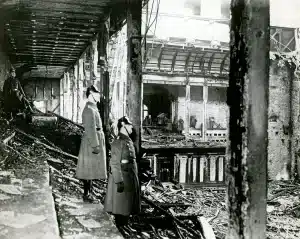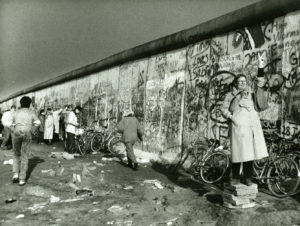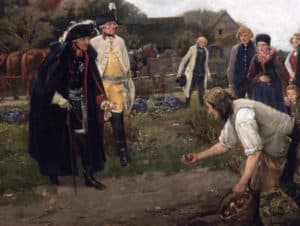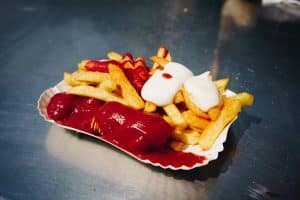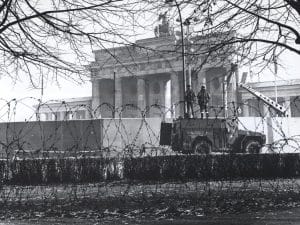“If beef’s the king of meat, potato’s the queen of the garden world”
Irish saying
When in 1951, American starlet Marilyn Monroe was dressed down by a catty critic as only being beautiful because of her clothes, her response was to organise a photo shoot wearing a burlap potato sack – and in doing so prove an important point: that the side dish can be truly awful, as long as the main course makes your mouth water.
German cuisine is not generally known for its mouth watering main courses – nor its inspiring side dishes either, where potato seems to feature prominently. Although any allegory of Marilyn Monroe soon falls apart when we consider that the burlap sack may indeed represent potatoes, but the part of Monroe on a German plate is almost exclusively played by a stonking great piece of pork.
Hardly flattering. Even when dolled up in diamonds and heels.
Take note of the three pork and potato dishes mentioned in the opening paragraph – which may be considered ‘German’ but are of varied origin themselves.
- The Schnitzel, which is claimed by Austria in its Viennese form, while having imitators and potential predecessors elsewhere – typically comes served with fried potatoes in Germany.
- The Schweinshaxn, an oven roasted pork knuckle popular in the south-eastern Bavarian region of Germany, usually found with potato salad.
- And last but not least, Königsberger Klopse – a meatballs dish traditionally made with veal and pork served in capers sauce with boiled potatoes, named after the coronation city of the Prussian Kings, now known as Kaliningrad and a semi-exclave of the Russian Federation.
Three dishes united in their utilisation of the humble potato (if we are to make one assumption about German cuisine it would be that it often comes with potato).
But three dishes also from a time before Germany existed.
An important point to bear in mind here, whilst we consider the matter of the potato and its provenance.
We can swiftly deal with one misapprehension when questioning what part Frederick the Great played in popularising the spud in Germany.
That of chronology.
Germany as we think of it now would not really exist until 1871 – when the country was first united following the defeats of Denmark, Austria, and France at the hands of Prussia and its allies. As such, during Fredrick the Great’s rule – from 1740 until 1786 – it would have been impossible for him to introduce the potato to ‘Germany’ per se.
Perhaps better then in our inquiry to consider whether Fredrick could be seen as being responsible for introducing the potato to his Kingdom of Prussia – and how, if that were the case, that affected the popularity of the potato on the European continent.
As to talk of Germany before its unification in 1871 would be comparable to talking of modern day Latin America – a region identifiable by its shared language and culture, although not gathered under one flag; or into one unified state.
Fittingly, it was from what we now know as the largest part of Latin America – South America – that the first potatoes arrived on European shores.
–

The Potato-Non-Grata
“Those who would give to the Spaniards the honour of entrencing (sic) this useful root called the potato, give me leave to call designing parricides, who stirred up the mislead zeal of the people of this kingdom to cast off the English government which is the greatest mercy they ever enjoyed… To ascribe the honour of the English industry to the effeminate Spaniards cannot be passed over without remark… and if I might advise the inhabitants, they should every meal they eat of this root be thankful to the Creator for English navigation.”
Anglo-Irish botanist Caleb Threlkeld
Although domesticated around 7,000-10,000 years ago, potatoes were not introduced to Europe until the mid-16th century – by Spanish explorer Gonzalo Jiménez de Quesada. Quesada returned from South America in 1565 after encountering the vegetable, along with the people of the Muisca Confederation, on his search for El Dorado – the man, the city, the kingdom, or interchangably the empire of gold (depending on who was believed at the time).
This conquistadorial connection is still evident in the English word for the potato, which comes from the Spanish term ‘patata’.
It is still sometimes said that Elizabethan-era English explorers Walter Raleigh and Francis Drake were actually responsible for introducing the potato to Europe – although this is known to be demonstrably false.
Raleigh certainly played a significant role in popularising tobacco in Great Britain but his earliest expedition, in 1578, took place well after Spanish explorer Quesada had already returned to Europe bearing the fruits – and vegetables – of his travels. Similarly, Drake returned in 1580 – seven years after the Hospital de la Sangre in Seville, Spain was already buying potatoes as part of their regular housekeeping.
To the contrary, it could in-fact be argued that Sir Walter Raleigh did more harm than good – as far as the potato is concerned – after reportedly gifting a batch of spuds to Queen Elizabeth I for a banquet in 1586. The kitchen staff mistakenly cooked the flowers and threw the potato away; leaving the guests worse for wear and Elizabeth thoroughly unimpressed with this dirty vegetable.
Like the tomato, the potato is a nightshade and the vegetative and fruiting parts contain a toxin which is dangerous for human consumption.
No surprise then that after its arrival in Europe, it was mainly considered fit only to be used as animal feed or the body of the potato discarded so the flowers could be used for decoration. Some religious authorities even deemed the potato unsuitable for human consumption – as it was not mentioned in the Bible – earning it the nickname, the ‘Devil’s Apple’.
Much has changed in the last five hundred years: there are now around 5,000 different types of potatoes available worldwide, making the these starchy tubers the fourth largest crop on the planet – after maize, wheat, and rice.
In 1995, potato plants were even taken into space aboard the space shuttle Columbia – marking the first time any food was ever grown off-planet.
Back in the 16th century, however, peasants in Spain would initially only resort to eating the potato as a way of staving off famine. Much of the Spanish landscape was too dry for potatoes to take but in a few isolated areas of northwest Spain, the potato soon began to flourish. Basque fishermen were known to use them as ship stores for their Atlantic voyages and would come ashore in Ireland to dry their catch – likely introducing the potato there when returning from the Grand Banks of Newfoundland.
Of the four blockbuster crops – wheat, potatoes, maize, and rice – it would be wheat (sometimes referred to as ‘corn’ in the English speaking world) that would be the initial dietary driving force behind European growth – until the arrival of the potato poured gasoline on that fire.
Wheat had spread westerwards through Europe from the regions of the Fertile Crescent around 8500BC – bringing with it high yields and a crop that could be easily harvested and stored.
The domestification of this important source of carbohydrates, that is also relatively high in protein, would faciliate the transformation of human society from dispered nomadic hunters to settled villagers. The most valuable crop in the modern world – bread wheat – which originates from the Fertile Crescent in hybrid form, would not only feed peasants and kings – but allow farmers to operate beyond subsistence level and become self sufficient – producing a surplus for trade.
Reliance, however, on a single crop – and one that can be so easily stolen once it is processed and stored – would prove far from ideal. Bread never disappeared from the diet of the north European population, but the arrival of the potato would eventually displace it as the principal food of the poorer classes. The introduction of the potato to European gardens and fields provided a much needed additional food source. They were cheaper, required less preparation, and per acre provided a higher caloric yield more than twice that of wheat.
Spanish ships would carry potatoes to Italy, where they would start growing in the gardens of the Po valley by about 1560; soldiers moving across the European continent – from Italy to the Rhineland and Low Countries along the ‘Spanish Road’ – would bring potatoes with them, that would take root wherever they set foot.
Natural suspicion of this alien food – compounded by fears stoked by religious authorities – would soon be outweighed by the ability of potatoes to keep a family alive on a war ravaged continent where military seizure of wheat meant that wherever a local population relied on stored grain for survival, outright starvation was the usual and expected result.
During the Austrian Wars of Succession (1740-1748), Prussian King Frederick the Great would realise how important potatoes were to keeping his peasants alive – organising distribution of free seeds throughout his Kingdom with instructions on how to grow them. As a consequence, even when Prussia was on its knees during the Seven Years War (1756-1763), fighting against a coalition of French, Russian, and Austro-Hungarian troops, Prussian peasants were still able to escape disaster by eating potatoes.
A food of last resort would soon be transformed into a staple; and acutely aware of the benefits that the humble potato offered in extending the northern European food supply, Frederick the Great would embrace ‘the Devil’s Apple’.
–
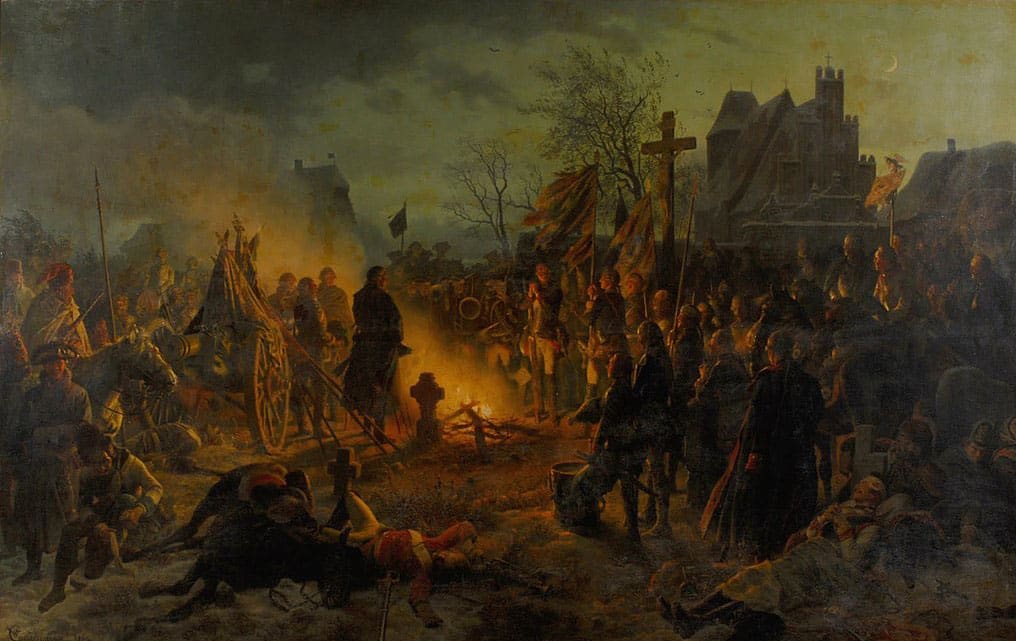
'Der Kartoffelkoenig' - Frederick the Great
“You are to make the benefit of planting this crop clear to the lords and subjects, and advise them to undertake the planting of potatoes this early year as a very nutritious food…Wherever there is an empty space, the potato should be cultivated, since this fruit is not only very useful to use, but also so productive that the effort put into it is very well rewarded.”
Frederick the Great’s Potato Order of March 24th 1756
In order to fight, every army has to be fed and the movement of armies during Frederick the Great reign in the 1700s would require a huge logistical effort. Food stuff had to be procured, not only for the fighting men but also their horses. To embark on a campaign with the intention of living out of the country was considered only a last resort – preparation would be key to any military victory.
Like most armies in the 1700s, the Prussian army largely relied on bread – but this could not be taken on long campaigns as it would spoil quickly, so instead flour would be transported and bakeries established in the field.
For the Prussian soldier a bread portion for one day was 1kg. To bake 100kg of bread, 75kg of flour were needed. For an army with an entitlement of 100,000 portions of bread, the daily requirement of flour was more than 70,000kg. Additional to this was the meat ration provided, spirits, and vegetables; but once the bread supply was assured, a commander could largely plan his future operation without particular feeding concerns.
For the time, the Prussian soldier was treated better than soldiers in other armies: the Austrian soldier had to pay for his meat ration; which usually acted as an inducement for desertion to the Prussian side. The Russian soldier would not receive bread but be simply given flour, which he would knead into dough and place into an individual fire hole to make his own bread.
Frederick would level off against both of the French and Russian armies during the Seven Years War (1756-1763) and as a result of a French blockade on grain imports began to place more emphasis on a vegetable that had arrived in the region around one hundred years before he took the throne, but had been largely neglected: the potato.
Transporting potatoes would not be easier than transporting flour but finding an alternative crop to wheat for his peasants would also free up more for his army to make into flour.
Frederick’s great grandfather – Elector Frederick William (‘The Great Elector’) – had brought the potato to Prussia, after encountering it in Bavaria – where it was being used as an ornamental plant.
According to historian Jürgen Luh, author of Der Grosse Kurfürst, the wife of the Great Elector of Brandenburg, Luise Henriette, grew potatoes on her small Botzow estate for some time before realising that this exotic delicacy was edible and tasty when prepared properly. As a result potatoes would be introduced to the garden of the Berlin Palace for consumption around 1655 – but take much longer to graduate from the botanical garden to the kitchen table outside royal circles.
It would take state intervention to make this happen; as field agriculture in Prussia was strictly governed by custom that prescribed seasonal rhythms for plowing, sowing, harvesting and grazing animals.
One hundred years after the introduction of the potato to the Berlin Palace, on March 24th 1756, Frederick the Great issued an order to hugely increase potato crops for consumption within his country – it would be one of fifteen such decrees regarding potatoes issued in his lifetime.
Tim Blanning, author of the biography of Frederick the Great that shares the King’s name, notes the increased interest in potatoes during the Frederick’s reign.
“One special concern, almost an obsession, was the promotion of the potato as a field crop…This was eminently sensible, for the potato was European agriculture’s most powerful weapon in breaking the age-old overdependence on grain as the staple crop.”
Frederick himself did not know the potato from his youth – he had been raised on barley and grain porridge, cabbage, and beer soup. He is said to have become acquainted with it at the court of his sister Wilhelmine in Bayreuth and to have immediately recognized its importance for the nutrition of the Prussians.
“It has been estimated that in the eighteenth century the yield of the potato per acre was 10.5 times higher than wheat and 9.6 times higher than rye, which more than compensated for its lower caloric value.To put that statistic another way, the net caloric value of a potato is 3.6 times that of grain. It has been estimated that ten square meters of land would produce 500 kilocalories in meat, 2,000 in cereals, 6,300 in cabbage, and 7,200 in potatoes.”
Modernising Prussia was one of Frederick’s life-long priorities, when not out fighting with his army – as he set about transforming his kingdom from a European backwater to an economically strong and politically reformed state. A policy of agricultural reform would be an integral part of this elevation of his entire state and his subjects. Frederick was intrigued by almost every aspect of life in his kingdom – but would take a particular interest in agriculture, saying that “True wealth is only what the earth produces” and “Agriculture is the first of all arts.”
Around a thousand new villages would be established in Prussia during Frederick the Great’s rule, bringing more than 300,000 new people to the land. Taming and conquering nature, which, in its wild form, Frederick regarded as useless and barbarous, was of great importance, and through undertaking a massive drainage program Frederick created roughly 150,000 acres of new farmland in the Kingdom’s Oderbruch marshland. Farmers were advised to grow potatoes and turnips in order to prevent a famine in Prussia – but the king had trouble making his potatoes palatable to his peasants. Frederick coined the phrase ‘Potatoes instead of Truffles!‘ and launched a propaganda campaign for the subterranean field crop.
Still not everyone was convinced.
The people of the town of Kolberg, for instance, officially replied to the King’s order to grow potatoes by saying:
“The things have neither smell nor taste, not even the dogs will eat them, so what use are they to us?“
Rumour is that Frederick responded by threatening to cut off the ears and tongues of the people of Kolberg – although this did not happen.
One of the most oft-repeated stories about Frederick’s relationship with the potato concerns the ingenious tactic of reverse psychology the King embarked on to increase interest in potatoes: rebranding it as a ‘royal vegetable’. By ordering his soldiers to plant potatoes in royal fields and lightly guard the crops, allowing the locals to sneak in and pillage the vegetables – the Prussian king would conclude: what is worth guarding is also worth stealing.
Whether this detail is true or not is still debated – Kurt Winkler, the Director of the Haus of Brandenburg-Prussia History claims that this story is older and actually originates in France, an assertion which brings with it its own problems.
Transforming the humble potato into a dish fit for a king also meant serving numerous courses of various preparations in his own household – whilst loudly consuming them in front of his guests.
His meddling with the diet of his subjects did not stop with potatoes – Frederick would famously demand that his subjects drink beer instead of coffee, in order to protect the Prussian brewing industry. Aware that self-sufficiency was preferable to relying on imported coffee from his rivals. Mulberry trees would also be planted to obtain silk, which was important for the domestic textile industry.
Frederick may have been a leader with a botanical vision – but he was first and foremost a feared military strategist – said to have acquired his sobriquet from his enemies who were so fearful of his military prowess.
In the last decade of his life he would embark on a campaign that would see his precious potato utilised in a way that until this point had been alien in European conflict – as a staple foodstuff crucially used to extend the time his army could spend in the field and ensure a tactical advantage.
The man who had built his international reputation through his military campaigns would be outshone in his old age – by the humble potato.
–
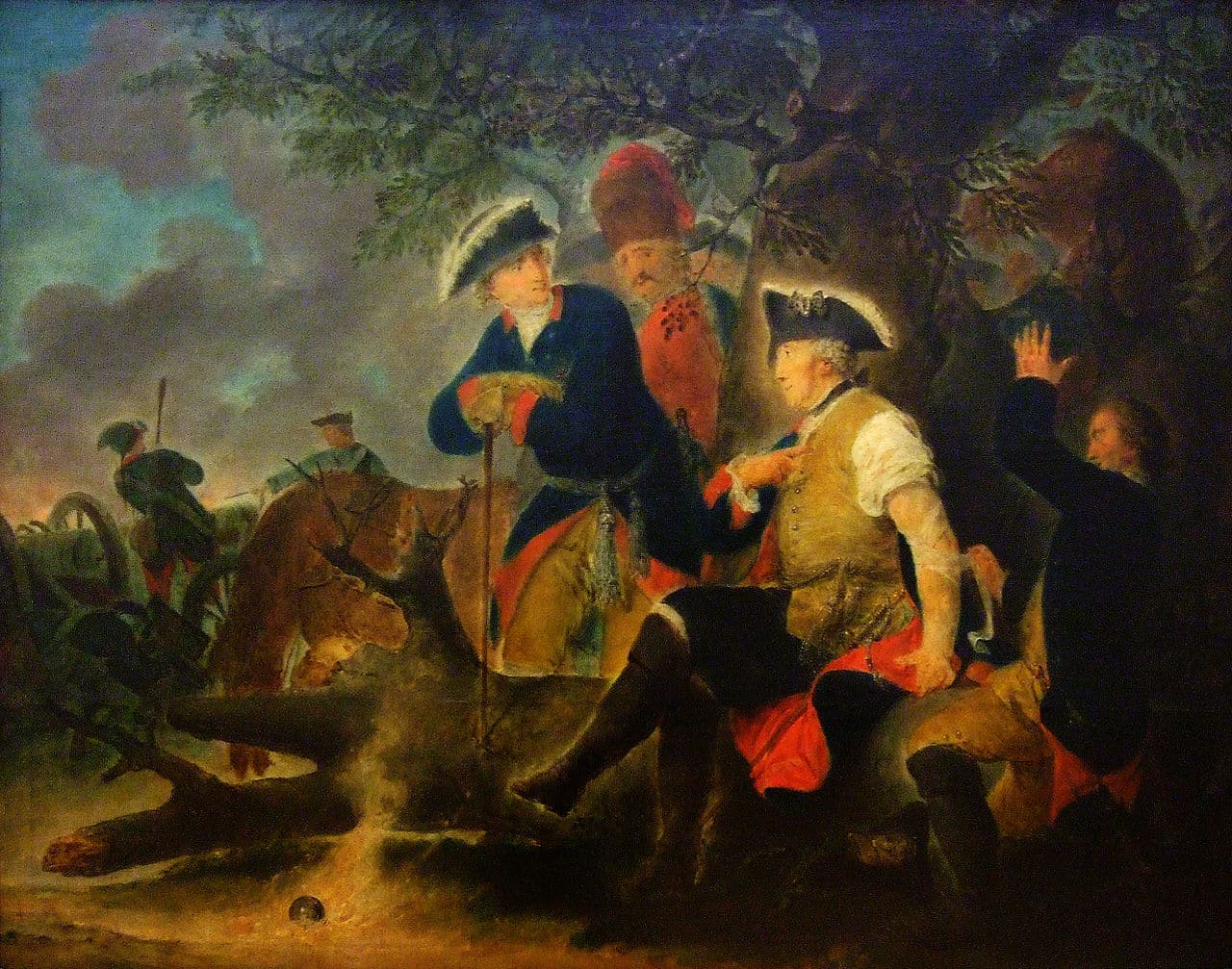
The Potato War Of Bavarian Succession
“Il faut surtout penser à vos subsistances, car une armée est un corps dont le ventre est la base; a quelque beau dessein que vous ayez imaginé, vous ne pourrez pas le mettre en exécution, si vos soldats n’ont pas de quoi se nourrir.”
“You must always keep in mind your supplies, for an army is a body whose belly is the base; whatever nice goal you might have imagined, you won’t be able to put it into execution, if your soldiers do not have something to feed themselves.”
Réflexions sur les projets de campagne, 1775
Frédéric II (Frederick II – Frederick the Great)
1775 was a terrible year for Frederick the Great. He finally lost too many teeth to be able to play his beloved flute. He would also have a series of attacks of gout and be tormented by abscesses in his ear and on his knee. He would live for another eleven years – but his few remaining friends were all dying around him.
Worse still, the political situation in Europe appeared much as ragged as Frederick’s body.
Hearing of the King’s frail condition, the Emperor Joseph of Austria-Hungary – who had taken the throne ten years earlier and served as co-regent with his mother Maria Theresa – sent an army to Bohemia, threatening to invade Brandenburg and Frederick’s lands on his death. The Austrian aim: retake the region of Silesia – Frederick’s first military conquest in 1740.
As Christopher Clarke points out in Iron Kingdom, the Austrians rightly viewed Silesia as a “dagger poised at the heart of the Habsburg monarchy”. It would be from these eastern territories that the Prussian forces would pounce in 1866, finally settling the matter of hegemonic control over the German speaking world once and for all.
In 1752, Frederick summarised the discontent oozing from Vienna: “Never will Austria get over the pain of Silesia’s loss. Never will it forget that it must now share its authority in Germany with us.”
The Austrians had already shown their expansionist intentions in 1770 when their seizure of two estates in Poland – ostensibly to stop the spread of plague – had triggered a rush to butcher the country and seen Prussia, Russia, and Austria-Hungary engage in the First Partition of Poland.
The death of the Elector of Bavaria, Maximilian III Joseph, from a virulent strain of smallpox in 1777 brought about the territorial expansion that Fredrick had feared, when the Austrians decided to compensate themselves for the loss of Silesia by annexing Bavaria. His natural successor, Charles Theodor, had agreed with Vienna to exchange his potential control of Bavaria for the Austrian Netherlands (Belgium).
The bipolar balance of power between Prussia and Austria in the 1700s had been disturbed.
The remaining German states viewed the Austrian annexation of Bavaria as a predatory power play by the House of Habsburg but the only European leader with the military strength – and interest – to intervene at this time was Frederick the Great.
Thus began one of the strangest military campaigns in Prussian history.
Frederick – at age sixty-six – was far too frail to lead his army but entirely opposed to Austrian expansion he mobilised his troops anyway. He would claim to be acting on behalf of the rival heir of Bavaria, Duke Charles of Zweibrücken, and travel in a coach – taking to a horse when the day of battle arrived.
Frederick left Berlin in April 1778 with an army of 100,000 men – but in his old age, he had lost the taste for war. He would soon be reinforced by 22,000 Saxons supporting their own ruler’s claim to part of Bavaria and with the Austrians scattered could easily have marched on Vienna. Instead, Frederick’s brother Prince Henry moved his forces into Bohemia in July, where a number of skirmishes allowed him to distinguish himself. Frederick’s eastern army entered Moravia and made little progress.
The winter that would follow would involve long months of maneuvering without serious engagement. By spring, the Austrians were simply waiting on one bank of the river Elbe with the Prussian troops opposite.
In October the campaign came to an end without any decisive engagement. The Austrian army had not moved. Alarmed by the shifting balance of European power, Maria Theresa – an opponent to the war – had been writing to Frederick behind her husband’s back and arranged for peace.
The chief business of this conflict had been in the feeding of vast static armies. Something Frederick’s little yellow vegetable had proven suitable for – and the soldiers, who did more foraging that fighting, came to call this the ‘Potato War’.
Potatoes in the soil of large parts of Europe can survive unaffected by frost in the winter, as the ground seldom freezes. Meaning that they can remain in the ground until the spring thaw when they begin to grow again. Foraging parties of soldiers during the ‘Potato War’ would easily harvest potatoes individually from the cold ground where they were essentially being stored, when the granaries were empty of wheat or the flour from the army logistics had been exhausted.
When the ground in Europe does freeze, the potatoes are harder to recover – although it is not impossible – and although the taste and texture is altered through freezing, the nutritional content remains undiminished.
A similar storage technique was being used, albeit intentionally, by the people of the Incan Empire when it was encountered by Spanish conquistadors. Potatoes would be stored in sealed, permanently frozen underground containers where the nutritional content could be preserved for several years.
This mode of food preservation would sustain the growth of the Incan civilisation; and in a less organised way – throughout the winter of 1778/79 – would also allow the Prussian and Austrian armies to remain in the field while their soldiers foraged for frozen potatoes.
With the Treaty of Teschen in May 1779, the Austrians finally gave up their claim to Bavaria and the war came to an end, although they did insist on keeping the rich district of Burghausen.
Thus Frederick saved Bavaria and its independence – with the help of a few potatoes along the way.
–

The French Connection - Antoine Parmentier
“I appreciate the potato only as a protection against famine, except for that, I know of nothing more eminently tasteless.”
Anthelme Brillat-Savarin in ‘The Physiology of Taste’ (1825)
Beyond the reputation he cultivated at home as a modernising and just leader, Frederick the Great longed to be remembered as a Philosopher King, a contemporary in the era of Voltaire, Rousseau, and Diderot. Indeed, like all these Enlightenment era thinkers, Frederick wrote and spoke in French. Leaving his works largely neglected by a Francophone audience suspicious of the old Prussian, and his native German speaking followers who found themselves incapable of deciphering the thoughts of the man who chose to use his foreign tongue.
His westward influence on the French, however lacking in philosophy certainly could be said to have been fruitful in cuisine.
Thanks to the capture of a French army pharmacist during the Seven Years War – a man named Antoine-Augustin Parmentier.
French speakers may be aware of Parmentier from the Parisian metro station that bears his name or the many potato dishes named after him. Crème Parmentier, for instance – a potato and leek soup; hachis Parmentier, a cottage or shepherd’s pie; brandade de morue parmentier, salt cod mashed with olive oil and potatoes; garniture Parmentier, cubed potatoes fried in butter; and most importantly purée Parmentier, mashed potatoes.
Parmentier was imprisoned by the Prussians, under Frederick the Great, and fed potatoes whilst in captivity – considered only suitable as hog feed in France at the time.
In 1748, France had actually forbidden the cultivation of the potato: it stood on trial with accusations that it caused leprosy, syphilis, early death and sterility – not to mention rampant sexuality.
This law would remain in place until 1772. Meaning that while Frederick the Great was convincing his subjects to plant potato crops – and tempting them with his ‘dish fit for a king’, the French were busy missing out on the benefits of this nutritious vegetable.
Enslaved by superstition and pseudo-science.
Permentier returned from Prussian captivity in 1763 and began working in nutritional chemistry – winning an essay in 1771 where the judges actually voted the potato as the best substitute for regular flour.
The year France’s potato law was finally repealed, Permentier proposed the potato as a source of nourishment for dysentric patients, in a contest sponsored by the Academy of Besançon. A contest he would go on to win.
Finally in 1772 the Paris Faculty of Medicine would declare the potato as edible.
Like Frederick the Great, Antoine-Augustin Parmentier would host dinners where potato dishes would feature prominently – even entertaining one of the founding fathers of the United States, Benjamin Franklin. Like Frederick, he would adopt the same strategy of surrounding potato patches with armed guards, only to withdraw them in the night so that people can steal the potato.
Eventually in 1800, Napoleon Bonaparte would appoint Permentier his first army pharmacist – seeing the success of his nutritional adventures.
Permentier recognised the potato’s potential in “reducing the calamities of famine”, his success and ability to almost-single handedly transform the French kitchen would not have happened without his time in Prussian captivity and the influence of Frederick the Great.
In another example of shared destiny, Permentier is buried in the Père Lachaise Cemetery in Paris, in a plot ringed by potato plants. Visitors to Frederick the Great’s grave in Potsdam will find a similar sight today, as raw potatoes are left in tribute daily where he rests.
**
Conclusion
Frederick’s Potato Order on March 24th 1756 was the first of its kind in Europe – perhaps the world – an order that potatoes be planted for consumption that would result in a fine if not obeyed.
At the time, the vegetable was still neglected by other European nations – either considered a mere ornament or worse, poisonous or devilish. An outlier crop that through Frederick’s intervention would take its place in the court of the king and the kitchen of the peasant.
It cannot be said that Frederick introduced the potato to Germany – by pure matter of chronology – although his promotion of the potato in Prussia, and the increase in popularity on the continent following his orders certainly had an immense impact.
Had Antoine-Augustin Parmentier not been captured alive by the Prussians or died in captivity, would the French have seen fit to change their minds about the potato?
Frederick the Great’s role in popularising the potato throughout Europe – and as such throughout the world – is undeniable. Although he is not solely deserving of the credit for the way the potato crop changed the world; his place in history is assured.
The potato remains an essential crop in Europe (especially northern and eastern Europe), where per capita production is still the highest in the world. Communist firebrand, Friedrich Engels, even declared that the potato was the equal of iron for its “historically revolutionary role”.
And as William McNeill writes in his study of the potato and its impact:
“It is certain that without potatoes, Germany could not have become the leading industrial and military power of Europe after 1848, and no less certain that Russia could not have loomed so threateningly on Germany’s eastern border after 1891.”
What a difference a spud makes.
***
Our Related Tours
To learn more about the history of Prussia and the life of Frederick the Great, have a look at our Glory Of Prussia tours.
Think you already know enough about life in the Iron Kingdom? Take our Glory Of Prussia Quiz and find out.
Sources
Blanning, Tim (2016) Frederick the Great: King of Prussia ISBN-13 : 978-0141039190
Clark, Christopher (2007) Iron Kingdom: The Rise and Downfall of Prussia 1600-1947 ISBN-13 : 978-0140293340
Diamond, Jared (1999) Guns, Germans, and Steel: The Fates of Human Societies ISBN-13 : 978-0393317558
McNeill, H. William (1999) How The Potato Changed The World’s History Social Research Vol. 66, No. 1, FOOD: NATURE and CULTURE
Mitford, Nancy (2011) Frederick the Great ISBN-13 : 978-0099528869
Snodgrass, Mary (2012) World Food: An Encyclopedia of History, Culture and Social Influence ISBN-13 : 978-0765682789



